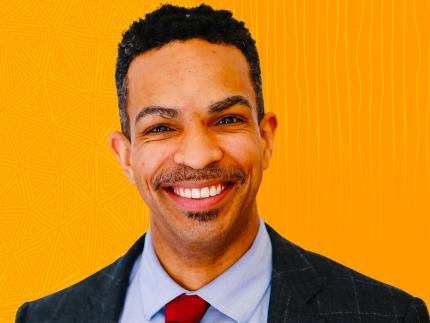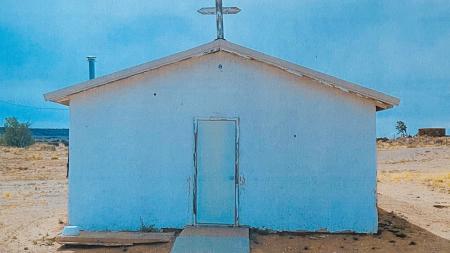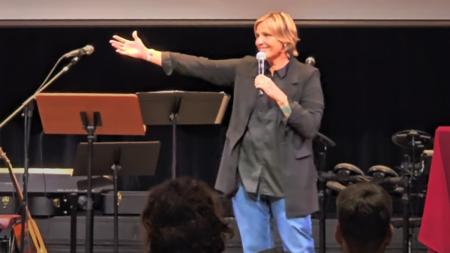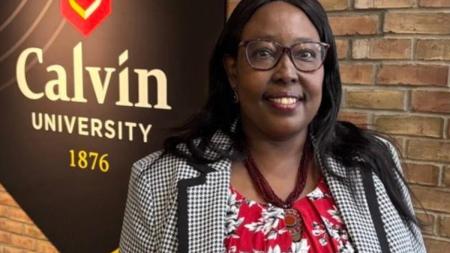Rebuilding What Is Broken

Dr. Daniel Lee Hill, an assistant professor of Christian theology at George W. Truett Theological Seminary, Baylor University, was at Redeemer University in Ancaster, Ont., Jan. 25 to accept the Emerging Public Intellectual award.
The award seeks to recognize and foster emerging talent in people working in Christian higher education, and it is sponsored and adjudicated by Redeemer University, Cardus, the Acton Institute, the Centre for Public Justice, the Henry Institute at Calvin University, the Council for Christian Colleges and Universities(CCCU), and The Richard John Mouw Institute at Fuller Theological Seminary.
In a lecture given in person to about 40 people and streamed online because of snowy conditions, Hill spoke of “Reweaving the Social Fabric: William Still and Public Life.” William Still is one of three abolitionists who are the focus of Hill’s upcoming book, Gospel Freedom (Baker Academic).
As we live in a world where the need for change is evident in many areas and elements of society, Hill asked, “What material difference does it make that ‘Christ has died, Christ is risen, Christ will come again’? How does that change the shape, the warp and weft, of our public life as Christians? And what shape does this engagement take so that we can point back to and bear witness consistently into our confession of the God of the gospel?” Hill further challenged his listeners to wonder how, as Christ’s ambassadors to a hurting world, we can promote human flourishing as witnesses to his reign.
Hill suggested that William Still’s life and work provide us with resources for thinking creatively about the work of preservation and what it looks like. “If it is indeed the case that Christ is Lord and we are not, and that this selfsame Lord is making all things new and liberating creation from its bondage to decay, then Christians bear witness in public through faithful resistance, hopeful anticipation, and loving preservation – and I’m putting that all under the heading of preserving the social fabric,” said Hill.
Hill explained that William Still was born in New Jersey in 1821 to former slaves, the youngest of 18 children. His father had purchased his own freedom but couldn’t afford to free his wife and four children that way, so Still’s mother escaped by fleeing.
After his mother fled, she and the four children were captured and re-enslaved. When she escaped a second time, she took only her two daughters, leaving the two sons. Since male slaves were more valuable, escaping with only her daughters meant a better chance of not being pursued. She was able to reunite with her husband, and together they had 14 more children, including William.
At age 23, William Still moved to Philadelphia, where he worked as a clerk in the Pennsylvania Society for the Abolition of Slavery, served as a station master for the Underground Railroad, and chaired a committee that helped and protected escaped slaves moving to or through Philadelphia.
After the Civil War and the end of slavery, Still continued to advocate for civil, voting, and transportation rights. He helped to form and fund the Social, Civil, and Statistical Association of the Coloured People of Pennsylvania, collecting data on people to understand the social condition with a goal of improving it. He was involved in starting an orphanage, served as president of the first Black-owned banking institution in Philadelphia, taught Sunday school each week, and helped to begin the first integrated YMCA in Philadelphia. He operated a local coal business to fund his life and work.
Hill noted that an important contribution in Still’s life was his role in the Underground Railroad, a collaborative network of pastors and other individuals to help fugitive slaves. Still is sometimes called the father of the Underground Railroad and the Angel of Philadelphia for personally assisting a thousand escaped slaves in finding freedom.
He used his own home in this work, risking his own life and freedom. He also organized rescue parties or funds to help specific slaves to escape or purchase freedom as requested by their friends and family members.
In addition, he was a meticulous record keeper. Much of what we know today about the Underground Railroad comes from Still’s records, over 800 pages of narratives and descriptions preserved in the book The Underground Railroad.
For example, one entry reads: “Daniel Hughes: Daniel fled from Buckstown, Dorchester County. His owner’s name was Richard Meredith, a farmer. . . . In features he is well-made, dark chestnut colored, and intelligent, possessing an ardent thirst for liberty.”
Why did Still record and publish these details for 995 individuals? He hoped to help reunite family members. He worked with descriptions and stories that included some record of previous owners and locations that could help people find loved ones separated by slavery or in the journey of escape. Still himself wrote that by his work he wanted “to provide the requisite resources for reuniting and comforting families” so that they could gather together after they had all “escaped bondage.”
Slaves who ran away often changed their names to avoid recapture; however, this also made it difficult for family members and friends who followed later. This is where Still hoped to help. He believed family to be important, saw how families can come unraveled, and found ways to help reweave their fabric. He was doing this decades before slavery was abolished because he anticipated an end to slavery and wanted to plan for it.
Still eventually met his own brother through his work. Having escaped slavery, his brother – one of the two left behind when his mother fled – came to the abolition office and described his mother for Still’s record book. From the details, they realized that they were brothers who had never met, since William had been born years after their mother’s escape.
Another purpose for Still’s work in recording stories, said Hill, was to inspire. Still recorded many stories of people who found creative ways to escape, such as one man who mailed himself in a box to a free state. They had agency in their own escape, said Hill, and Still highlighted their strength of character, inspiring others to find the courage to escape and to help others.
Hill noted, “Just as the testimonies of figures like Harriet Tubman, William ‘Box’ Brown, Henry Bibb, and Frederick Douglass inspired slaves to follow in their footsteps,” Still hoped that people would “read these stories and see heroes.”
“And insofar as you see heroes,” Hill added, “you’ll see someone worth emulating.”
In The Underground Railroad Still wrote that “‘through extraordinary determination and endeavor,’ such as are demonstrated in hundreds of cases in the pages of this book, in the struggles of men and women to obtain their freedom, education, and property,” he hoped his readers would continue that legacy and would display courage and ingenuity and be brave in their pursuit of freedom, said Hill. “Keeping track of these feats of bravery becomes a work of preservation – not just of historical memory, but of improvisational acts of virtue. What might the virtues look like in new and different settings?”
Hill identified three arcs in Still’s work: resistance, preservation, and anticipation. In resisting, we are called to call out and work against wrongs we see in society. In preservation, we seek to hold things together. In anticipation, we imagine a future and try to prepare for it.
The world in which we live needs renewal, said Hill, but we are situated within it and must act within it, preserving what is good, resisting what is wrong, and looking for better things. We live in a time where things unravel and need to be bound together. We have been sent as Christ’s ambassadors, and it is here that we can bear witness to God’s work in Christ and expect the Holy Spirit to act in surprising ways, bringing renewal.
Hill suggested that we also need hopeful anticipation in public witness – we anticipate the good that God will bring about. We can see this in Still’s record keeping created with the hope of reuniting families and a life of human flourishing for people in the future. He didn’t just daydream about reuniting families, but worked to create a place where people could go to make it a reality. He looked past the immediate crisis and saw what life could look like on the other side. We anticipate the future by gaining from the wisdom of the past, said Hill.
We live in a world where change, decay, and unraveling are the norm; however, the language of futility and decay isn’t meant to cause despair, said Hill, but to highlight the task we have to preserve things worth preserving – and, for Still, that included freedom and family.
We can also find inspiration from these stories, Hill suggested, envisioning good and working toward it. Ways of life and institutions will become corroded, he said, but it’s our job to bring renewal to what’s been corrupted: family bonds, marriage, children, education, public service.
Christians can also bear witness by remembering the past – so that we can see stories of courage or temperance, said Hill. What might temperance mean in a Google and Amazon world? In a world where computers and phones are the product of slave labor in cobalt mines and factories? Sometimes, he said, we can be part of the answers to our prayers that God would bring renewal.
Christian faith is a public faith, said Hill. We belong, body and soul, to God. God commissions us as his children, in covenant with him. “Inhabiting the time of futility and decay is not a cause for being overwhelmed with apathy, throwing up your hands, or refusing to ‘polish the brass on the Titanic,’ as is often said, because the ship will sink. The ship is not sinking! The ship will be made new. We are the called-out ones, the saints, and we are sent to reweave, to build up, to bind that which is breaking and broken.”


